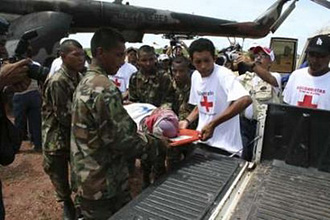 |
 |
 |
 News from Around the Americas | September 2007 News from Around the Americas | September 2007  
Death Toll From Felix Nears 100
 Olga R. Rodriguez - Associated Press Olga R. Rodriguez - Associated Press
go to original


| | Local Red Cross volunteers help the Nicaraguan air force retrieve casualties from remote communities devastated by Hurricane Felix in Puerto Cabezas September 7, 2007. The air force ran a helicopter shuttle from the airport at Puerto Cabezas to Sandy Bay, the coastal community most seriously damaged by the Category Five hurricane where virtually all houses have been destroyed or seriously damaged. The IFRC has issued a preliminary appeal for $825,000 to assist over 4,000 families for nine months. (Reuters/Alex Wynter/IFRC) |
Rescuers scooped bodies from the open sea and villagers paddled canoes through fallen trees looking for survivors on this remote, swampy stretch of Caribbean coast as the death toll from Hurricane Felix neared 100.

Residents of Puerto Cabezas said they had little warning of Felix's rapid approach and when the storm hit most of the men were out to sea fishing. The women and children left behind clambered on the few remaining boats which quickly sank because they were overloaded.

The government 'didn't warn us that the hurricane was coming,' said Anali Martinez, 21, whose cousin was among the missing after the Category 5 hurricane hit Tuesday. 'That's why so many were caught in it fishing.'

In Puerto Cabezas, about 500 people crowded onto a pier overlooking the beach where 13 bloated bodies had been laid out on black tarps after being pulled out of the sea. Some tried to rush down a small wooden stairway onto the beach but were held back by police.

Lucia Parista Mora, 43, whose nephew was lobster fishing when the hurricane hit, told The Associated Press that several hundred fishermen and female fish sellers were either on the three main cayes off Puerto Cabezas or in boats fishing.

'We want them to bring them back here,' said Parista Mora. 'Even if it is just bones, we want to see them.'

The impoverished region is inhabited by descendants of Indians, European settlers and African slaves who live in stilt homes on island reefs and in small hamlets, surviving by fishing and diving for lobster.

Felix developed very quickly over the warm waters of the southern Caribbean, and Nicaragua posted a hurricane warning less than 24 hours before it hit the coast, scrambling to notify the autonomous northeast where many people have a long-standing mistrust of the Nicaraguan government.

Few realized the storm would grow to a Category 5 hurricane so quickly, and some who were warned did not believe it would be so dangerous. But in Nicaragua it completely destroyed 7,995 houses in Puerto Cabezas, Waspan, Rosito, Iuna, Bonanza, Jinotega.

Abelino Cox, the spokesman for the Regional Emergency Committee, said late Thursday that the death toll rose by 33 to 98 as authorities searched the Miskito coastline that stretches across the Nicaragua-Honduras border.

He added that rescue brigades found the ethnic Zumo and Mayagna Indian community of Awastingni, located in the jungle 55 miles northwest of Puerto Cabezas, completely destroyed and that 14 were missing.

Maj. Abel Zepeda, deputy chief of Civil Defense in Nicaragua's northern autonomous region, said the death toll had increased to 96, including 44 Indian fishermen from the Miskito Caye, a tiny island off the Nicaraguan coast.

Their bodies were found floating in the ocean, said national Congressman Brooklin Rivera, a member of the regional emergency committee.

Television images showed the Miskito Cayes totally destroyed. All that remained were the trunks of trees that once supported more than 100 primitive dwellings on the barrier islands.

Sara Isolina Alvarado, who was rescued by the army, said authorities in Puerto Cabeza warned residents about the oncoming hurricane too late.

'We have no food, water, clothing, nothing. And we're cold,' she said.

Aid was arriving slowly and those who survived the storm lacked food and fresh water. An AP photographer reached one isolated village in Nicaragua where the only thing to drink was the water in fallen coconuts.

U.S., Honduran and Nicaraguan soldiers searched remote jungle beaches and the open sea Thursday for survivors and cadavers.

Rain pushed a river over its banks Thursday in Tegucigalpa, killing a pregnant market vendor. A small boy was missing after being dragged away by the river's current, emergency officials said.

The remnants of Hurricane Henriette, meanwhile, dumped rain Thursday on Arizona and New Mexico. That storm hit Mexico on Tuesday and Wednesday, near Cabo San Lucas and again near the port city of Guaymas, then weakened over the Sonoran desert. Officials said the death toll Henriette was 10.

Associated Press writers Freddy Cuevas in Tegucigalpa, Honduras, and Filadelfo Aleman in Managua, Nicaragua, contributed to this report. | 
 | |
 |



